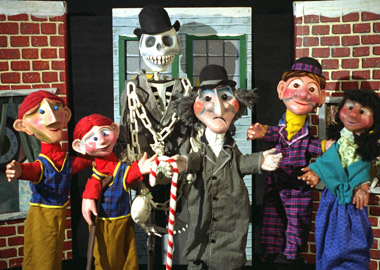The bumper sticker reads “We still say Merry Christmas,” in defiance of the season’s “Happy Holidays” generalization. Yuletide has irretrievably become a secular season in which the most popular non-liturgical celebrations and performances use a Christmas context to deliver an ecumenical message, or simply to entertain.
Of these, the lodestone is A Christmas Carol, which receives a tri-state assortment of productions this year, beginning this weekend. Performances over the next month also include that other hardy perennial, The Nutcracker, with a cast in the hundreds; David Sedaris’ near-classic diary of life as a Macy’s elf; a death-by-candy-cane murder mystery set in Santa’s workshop; and a puppet-based potpourri of worldwide traditions that have influenced the web of rituals we call Christmas.
Each of the region’s Christmas Carols has its own tone and take on Dickens’ tale of the mean old miser who gets the Scrooge scared out of him by midnight spirits. The Berkshire Theatre Group is moving its annual community-oriented production (Dec. 17-30) from the company’s intimate Stockbridge stage to the Colonial Theatre in Pittsfield thanks to the star power of Berkshires resident James Taylor, who appears as timorous clerk Bob Cratchit.
The emphasis in Hartford Stage’s Christmas Carol (Nov. 25-Dec. 30) is on spectacular special effects, including flying ghosts and a fiery chasm that swallows the chain-clanking shade of Jacob Marley. And in Vermont, the New England Youth Theatre presents a new adaptation by clown master Peter Gould (Dec. 8-11, 15-18) while Putney’s Sandglass Theater hosts the Crabgrass Puppet Theatre in Mr. Punch’s Christmas Carol, which leavens Dickens’ heartwarming moral with the knockabout slapstick of Punch and Judy (Dec. 29 only).
Tchaikovsky’s ballet The Nutcracker is the third-most-performed Christmastime story, after those of Dickens and, um, Jesus. This year’s edition by the Pioneer Valley Ballet, at the Academy of Music in Northampton (Dec. 9-11), is the troupe’s 32nd annual performance of the Russian fairytale. Over 200(!) children and adults enact dolls come to life, balletic flowers and snowflakes, soldiers of tin and gingerbread, with visions of a certain Sugar Plum dancing in their heads.
Two productions exploit the holiday strictly for laughs. In Lenox, Shakespeare & Company mounts The Santaland Diaries (Dec. 2-30) David Sedaris’ side-splitting memoir of humiliation as a department store elf, performed by one of the company’s resident clowns, Ryan Winkles. The August Company commits more violence against Christmas piety with Santacide, a spoof murder mystery penned by local wits Kelsey Flynn and Hilary Price (Dec. 17 at the Academy of Music).
Christmas, like Christianity itself, is a composite tradition, a skein of beliefs and practices woven from a variety of ancient customs. Solstice, at UMass (Dec. 1-3, 6-10) makes that point. Devised and performed by theater professor Miguel Romero’s puppetry workshop, the piece draws on folktales and myths from three continents and incorporates stylistic influences from circus, vaudeville, hip-hop, silent films and diverse theater traditions to explore, as Romero puts it, “how celebrations of light and darkness, and of the sun as the source of life, contributed to Christmas as we observe it today.” The performance, with an original score by Amherst College professor Eric Sawyer, features puppets fabricated from old shoes and boots (the “sole-stice” pun is intentional).



